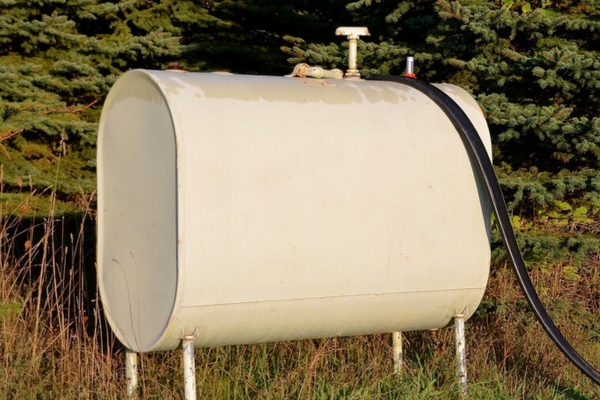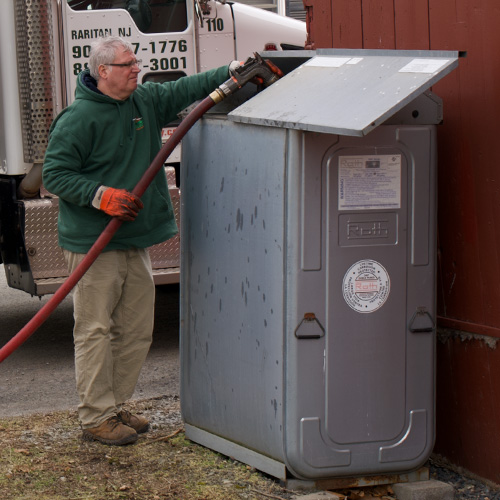Table of Contents
Many homes across the eastern United States rely on heating oil as their primary source of warmth, especially during the colder months. Heating oil is stored in a tank on the homeowner’s premises and funneled to their furnace or boiler to generate heat. When upgrading an existing oil tank, homeowners should evaluate the advantages of choosing a double-wall heating oil tank. This article from County Line Fuel explores the characteristics of double-wall oil tanks, their benefits, and why homeowners may choose to use them.
Understanding the Double-Wall Heating Oil Tank

A double-wall heating oil tank features a robust design with an inner tank enclosed by an outer tank. The area separating these two tanks is the interstitial space. This dual-layer setup acts as a safeguard, ensuring that any leakage or spillage from the inner tank is contained within the outer tank, preventing environmental contamination.
The interstitial space is sealed and equipped with sensors and alarms to alert the owner to any leakage. This feature ensures that if a leak does occur, the space effectively contains it, stopping it from reaching the environment.
Furthermore, double-wall tanks are fitted with a component known as a “spill bucket,” a compact container placed within the interstitial space to catch any leaks or spills. This adds an extra level of security, further mitigating the risk of environmental contamination.
You can trust County Line Fuel for all your heating oil and tank needs. We offer quality service and peace of mind. Call us today!
Functionality of a Double-Wall Heating Oil Tank
In a double-wall heating oil tank, the inner tank serves as the primary storage for the fuel, while the outer tank provides a secondary containment barrier. Should any leaks or spills occur in the inner tank, the outer tank’s interstitial space captures the escaping fuel. This containment prevents the fuel from dispersing into the environment and creating hazardous conditions.
Advantages of Using a Double-Wall Heating Oil Tank

Double-wall heating oil tanks present multiple advantages compared to their single-wall counterparts. The foremost benefit is their enhanced protection against leaks and spills. A secondary containment barrier in double-wall tanks offers an additional layer of security, a feature absent in single-wall tanks.
Additionally, double-wall heating oil tanks are designed for durability and longevity. The outer tank is often constructed from high-density polyethylene (HDPE), a material known for its durability, resistance to UV light, and ability to endure harsh weather conditions. This robust construction makes double-wall tanks an excellent choice for outdoor setups, ensuring a longer service life under varying environmental stresses.
Need a new oil tank? Trust County Line Fuel for top-quality installations and maintenance. Call now!
Double-Wall Heating Oil Tank FAQs
Here are some frequently asked questions about double-wall heating oil tanks:
Are Double-Wall Heating Oil Tanks More Expensive than Single-Wall Tanks?

Double-wall heating oil tanks usually cost more than single-wall tanks. This higher initial investment is attributed to their advanced design, which provides additional protection against leaks and spills and enhanced durability. These features often make double-wall tanks a more economical choice over time, considering their potential to prevent environmental damage and reduce maintenance costs.
Firstly, the construction of double-wall tanks involves more costly materials. While the inner tank uses materials similar to what they use for single-wall tanks, the outer tank typically contains high-density polyethylene (HDPE). HDPE is more expensive than the steel or standard plastic commonly used in single-wall tanks.
Second, the manufacturing process for double-wall tanks is inherently more complex. Each tank—the inner and outer—must be individually crafted and then carefully assembled together, increasing labor and production expenses. Furthermore, the interstitial space between the two tanks must be meticulously sealed and undergo rigorous leak testing, further elevating the production costs.
Third, installing double-wall tanks is more intricate than installing single-wall tanks. Proper tank leveling is crucial, and continuous monitoring of the interstitial space for leaks is necessary, increasing installation costs.
Lastly, double-wall tanks are built to be more durable and have a longer lifespan, positioning them as a prudent long-term investment. Although they are more expensive initially, the potential savings from reduced repair and replacement costs over time can justify the higher upfront expense.
Can I Install a Double-Wall Heating Oil Tank Indoors?

Yes, you can install double-wall heating oil tanks indoors. However, to avoid fume accumulation, the tank must be placed in an area with adequate ventilation. When setting up a double-wall heating oil tank inside, adhere strictly to the manufacturer’s guidelines and local building codes.
Ensuring proper ventilation, such as routing a pipe to vent fumes outdoors, is crucial to prevent hazardous fumes from building up indoors. It’s also important to consider that installing a double-wall heating oil tank indoors often necessitates extra safety precautions, like placing a spill containment tray under the tank to manage any possible leaks or spills effectively.
Consulting with a professional experienced in heating oil tank installations is always advisable to ensure the best practices are followed and to guarantee compliance with safety regulations and standards.
Ensure a reliable heating oil supply. Sign up for automatic deliveries with County Line Fuel today!
Does the Law Require Double-Wall Heating Oil Tanks?
The requirement for double-wall heating oil tanks is not uniform across all areas; it varies by state and local jurisdiction. Although not universally mandated, many states have regulations that necessitate secondary containment measures for fuel storage tanks.
In certain regions, regulations stipulate that newly installed tanks must be double-wall, whereas in other areas, this requirement may only apply to tanks that are being replaced. Furthermore, some rules mandate that existing single-wall tanks be upgraded with secondary containment solutions. This could involve replacing them with double-wall tanks or equipping them with an additional containment tray to meet safety standards.
It’s prudent to consult with your local government agency or a professional familiar with the regulations specific to your area regarding tank installation. Doing this ensures that your tank complies with legal requirements, helping to keep your fuel storage safe and secure.
Conclusion
A double-wall heating oil tank is a superior choice in fuel storage, delivering enhanced protection against leaks and spills. Its benefits include increased durability and secondary containment, making it a compelling option for homeowners considering replacing their existing oil tank. Despite the higher initial cost compared to single-wall tanks, the long-term advantages, such as improved safety, reduced environmental risks, and greater peace of mind, often justify the investment.
Call County Line Fuel for Reliable Heating Oil Deliveries

County Line Fuel is dedicated to supplying reliable heating oil delivery services to homes and businesses in Clinton, NJ, and the surrounding areas. We prioritize prompt and efficient delivery of high-quality heating oil, ensuring your comfort and warmth without any hassles. Our commitment to outstanding service is demonstrated through competitive pricing and clear communication, with your comfort as our primary focus.
Choosing County Line Fuel means partnering with a dependable provider for all your heating oil needs. Renowned for our trustworthy services and strong commitment to customer satisfaction, County Line Fuel remains a staunch supporter of the community. We are ready to fulfill your heating requirements and keep your space cozy and welcoming. Contact us today to get started!
You can click here to contact us now or call us at (908) 735-7610 to find out more! Click the link to view our service area.
Related Articles:
